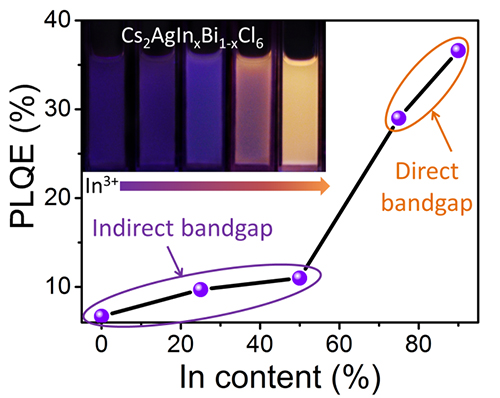
A research team led by HAN Keli from the Dalian Institute of Chemical Physics (DICP) of the Chinese Academy of Sciences synthesized lead-free direct band gap double perovskite nanocrystals (NCs) with bright dual-color emission. Their findings were published in J. Am. Chem. Soc..
Lead-based perovskite NCs with near-unity photoluminescence quantum efficiency (PLQE) and tunable emission in the visible region are potentially applied for various optoelectronic applications, such as light emitting diodes, lasing, and photodetectors. Unfortunately, the toxicity of Pb is often considered as a drawback, leading to the efforts of finding a possible replacement.

PLQE of Cs2AgInxBi1-xCl6 (x=0, 0.25, 0.5, 0.75 and 0.9) NCs and the PL image under UV light. (Image by YANG Bin)
The researchers synthesized a series of lead-free double perovskite NCs that is Cs2AgInxBi1-xCl6(x = 0, 0.25, 0.5 0.75 and 0.9), that could be tuned from the indirect bandgap (x = 0, 0.25 and 0.5) to the direct bandgap (x = 0.75 and 0.9).
Direct-bandgap NCs exhibited 3 times greater absorption cross-section, lower sub-bandgap trap states, and larger than 5 times PLQE compared with those observed for indirect bandgap NCs (Cs2AgBiCl6). A PLQE of 36.6% for direct bandgap NCs was comparable to those observed for lead-perovskite NCs in the violet region.
They conducted the spectroscopic characterizations of the double perovskite NCs by using femtosecond transient absorption spectroscopies. It was found that the indirect band gap NCs exhibted prominet sub-band gap trapping precesses while which was negligible for direct band gap NCs.
The design of lead-free direct bandgap perovskite NCs with superior optical properties opens the door for high performance lead-free perovskite optoelectronic devices.
This work was supported by the National Natural Science Foundation of China.

86-10-68597521 (day)
86-10-68597289 (night)

86-10-68511095 (day)
86-10-68512458 (night)

cas_en@cas.cn

52 Sanlihe Rd., Xicheng District,
Beijing, China (100864)

